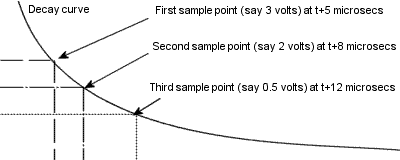Some time ago I saw an old patent that described a seach head for PI and a new approach to sampling. I had it for years in my mind, so recently I deside it was time to try it.
We have the usual transmiter that gives the decay curve to sample. The idea is that instead to wait some usec and then sample, why not sample a fast timer with a good comparator at fixed voltage levels say 5volt, 3volt and 1volt. This will give us three timings with say reference the stop of tx pulse. Subtracting each from the other will give us coordinates for discrimination. The decay curve does not change shape with distance.
I believe it's a good idea and worth a try.
I'll use a microcontroller for all the timing and comparator work (propably the AT90S2313).
Any opinions?
We have the usual transmiter that gives the decay curve to sample. The idea is that instead to wait some usec and then sample, why not sample a fast timer with a good comparator at fixed voltage levels say 5volt, 3volt and 1volt. This will give us three timings with say reference the stop of tx pulse. Subtracting each from the other will give us coordinates for discrimination. The decay curve does not change shape with distance.
I believe it's a good idea and worth a try.
I'll use a microcontroller for all the timing and comparator work (propably the AT90S2313).
Any opinions?


Comment